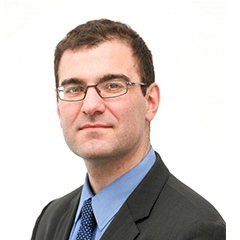Enhanced recovery is a modern evidence-based approach that helps people recover more quickly after having major surgery. David Lynch spoke to a consultant in Cappagh National Orthopaedic Hospital, which is leading the way in the area in Ireland
Most patients do not want to spend excessive time in hospital.
Enhanced recovery is about minimising the time patients spend in hospital following an operation or procedure. When patients feel well enough they will be mobilised by the physiotherapists with the view of being home as soon as possible with a home exercise programme.
One hospital which is very involved in enhanced recovery is Cappagh National Orthopaedic Hospital.
“The traditional way that hip replacements, joint replacements are done, is that you would come into hospital, and there would be an expectation that you would be in hospital for a week at a time,” Dr James Cashman, Consultant Orthopaedic Surgeon at Cappagh told the Medical Independent.

“The recovery was very slow, and traditionally, orthopaedics has had a reputation for having complications, such as pressure sores, blood clots. That all fed into the long hospital stay. [But] the aim of doing joint replacement, like a hip renewal replacement, is to get people back to normal as fast as possible, improve quality-of-life and improve pain, but basically get them back to normal.”
Dr Cashman added that “people who typically go for elective joint or hip replacement are generally well; they are healthy people”.
“But they have a joint pain. If you do an operation to get rid of the joint pain, you want to get them back to normal as quickly as possible. Over the last number of years, there has been a move towards shorter lengths of stay, which result in, ideally, reduced complications such as blood clots, infections, pressure sores and these sort of things.
“But [it] also leads to an earlier return to normal functions. So the aim of the enhanced recovery programme is to get patients back to [normal] as soon and early as possible.”
Evolution
Dr Cashman stated that “the evolution of it has been that the length of stay has gradually gone down with better pain control, better patient education, maybe better surgery, and certainly better anaesthesia.
“And it has now reached the point where some patients can go home on the same day, so some patients are done as a day case. It’s streamlining the whole system, so patients realise it is not about being in hospital for two weeks laid-up and then going on to a nursing home. Rather, the whole episode of care is more compressed and streamlined.”
So it seems that patient engagement is vital to make this whole system work?
“Yes, so most people going for a joint replacement have never been for a joint replacement before, so they don’t know anything about it,” he said.
“So they might have these preconceptions based on their grandmother who had it 20 years ago, or something like that. They come in with no knowledge, or out-of-date knowledge,” Dr Cashman said.
“So we try to engage the patient in what’s going to happen, make them, I suppose, a little bit responsible for their care, but certainly give them the education and empower them to be involved. What that involves is telling them about it in the outpatient clinic. In Cappagh, we have a pre-assessment clinic, whereby they meet nurses, physios, [and receive] pre operative education so they know what to expect when they are coming in, so it’s not all a surprise.”
The spread of enhanced recovery has taken place across the globe in recent years in varied ways, Dr Cashman said.
“Enhanced recovery as a concept is pretty widespread, how it is implemented is different in [different] places and different hospitals,” he added.
“In places like in the [United] States and some centres in Scotland, Fife is pretty good — their length of stay is really quite short and there are some patients for whom one day [stay in hospital] is reasonable.
“Now, that depends on the patient; there is a certain amount of geography involved. You can’t expect someone to go home [on the same day] if they live in west Donegal or west Kerry,” he added.
“There is a need for some social support. Ideally, you would like someone to check in on the patient the next day [after the operation], a family member or whatever. So it may not be quite as appropriate.”
However, Dr Cashman said that “for the vast majority of people, you can certainly do it in a shorter space of time.
“My 80-year-old patients would typically be fit to leave the hospital after two days, my younger patients would be fit to go earlier…[enhanced recovery] can be applied pretty universally.
“If you tell them they can go home, most of them are happy to go home. But if they don’t know about it before they come into hospital, they don’t buy into it, because they have all this apprehension and all these worries about this operation. So they really very much need to be engaged beforehand.”
Support
Although there would seem to be some possibility of cost savings around such a system, Cappagh Hospital is more focused on the innovative nature of enhanced recovery and what the research is saying.
“Really, generally with enhanced recovery, everyone is in favour of it,” Dr Cashman said.
“Not everyone does it to the same extent. People engage with different parts of it, in general people are very positive about patients recovering faster, having fewer complications and getting back to normal faster.”
He adds that it is “good for pain management”.
“When you introduce a programme like this, all processes get a bit more streamlined. The way we manage our patients gets a bit better, and patients are happier, so everyone is on board with that sort of thing.”
The process in place in Cappagh has been ongoing for a number of years.
“It kind of has been in evolution for the last couple of years,” Dr Cashman said.
“The thing that we started last June, was the [aim to have] same day — so [patients] in and out on the same day.
“I started as a consultant five years ago; the length of stay was about five days, the mean length of stay is now down to three-and-half days, I think.
“So for some patients, it is not appropriate — if you have elderly patients or those who are a little more infirm, then they cannot engage with it to the fullest, so that is why the length of stay is not quite as short as two days universally.
“But yes, it has come along great and we haven’t seen an increase in orthopaedic complications — there aren’t more fractures, dislocations or falls, or infections because of this programme, which is one of the concerns that patients would have.”
Enhanced recovery efficiencies
A Cappagh Hospital spokesperson provided a sequence of treatments for a patient on the day of surgery to demonstrate enhanced recovery efficiencies.
10am: Seen one hour post-right total hip replacement in recovery room. Provided with fentanyl secondary to pain by recovery room staff. Inappropriate to proceed with intervention currently. (For subsequent patients n= 3 physio wait until they come back onto the wards.)
1.20pm: On o2 via nasal cannula 2L and drowsy according to N/s. Not suitable for intervention.
2pm: CMS fully returned. Bed transfers completed, minimal assist x1. Mobile approx 10ms using 2x crutch. Sat out in chair post-treatment. Good mobility demonstration.
6pm: Pain 2/10 at rest; 5/10 on movement. Described improvement in pain levels. Brought to gym area. Completed 3x10ms using crutches and supervision. Stairs completed 1x rail, 1 x crutch independent. Able to recite and complete previously provided exercise programme from the discharge and treatment plan that is completed by nursing before the patient leaves at the end of their day of surgery. Safe mobility demonstration achieved and suitable for inpatient physio discharge.
8pm: Discharge Cappagh Hospital to sister’s house for the evening and planning to travel to own home the following afternoon.
1pm following day: Follow-up phone call with patient. Back in Wexford and supported by partner. Happy with outcome of surgery and enhanced recovery — to be followed up in Mr Cashman’s clinic later.
Returned to clinic for review. Doing well, did not require any other physiotherapy intervention.












Leave a Reply
You must be logged in to post a comment.